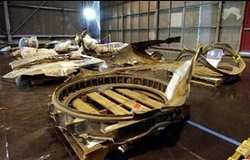Scientists Explore Metal's Burn Characteristics
The predominant component in the shuttle's structure, aluminum,
can change under certain circumstances, becoming a fast-burning,
explosive fuel of the sort used in armor-piercing munitions, bombs,
and rocket boosters. That fact has led the Columbia Accident
Investigation Board to inquire into the possibility that, as
trouble mounted during Columbia's hot, violent re-entry, parts of
its very frame might have ignited or even exploded.

Possibly Fueled Disaster?
 If so,
the burning aluminum may resolve what seems to be a contradiction
that has troubled investigators from the start: Physical evidence
indicates that destructive heat raced through the shuttle's left
wing, but engineering calculations indicate that scenario could not
have unfolded as fast as it evidently did. The explanation, said an
official close to the investigation, may be that the aluminum alloy
in the frame could have served as a kind of energy multiplier,
accelerating the chain of disasterous events that eventually doomed
Columbia and its crew.
If so,
the burning aluminum may resolve what seems to be a contradiction
that has troubled investigators from the start: Physical evidence
indicates that destructive heat raced through the shuttle's left
wing, but engineering calculations indicate that scenario could not
have unfolded as fast as it evidently did. The explanation, said an
official close to the investigation, may be that the aluminum alloy
in the frame could have served as a kind of energy multiplier,
accelerating the chain of disasterous events that eventually doomed
Columbia and its crew.
"The more we learn about how aluminum behaves in these
superheated temperatures, the better," said retired Admiral Harold
Gehman, the board's chairman, at a news briefing this week. When
aluminum gets superheated and turns into fuel, he said, it ceases
to be a barrier. Instead, "this presents a new avenue for
heat."
It Would Explain A Lot
 The accident unfolded in a mysterious environment
of hypersonic speeds and rarified atmosphere, in which aerodynamic
forces, chemical reactions, and extreme heating interact in ways no
on can yet predict. As specialists have told the board, there have
been few opportunities, until now, to study what happens to
spacecraft hardware when it barrels through the upper atmosphere
and into the thicker layers of gas below.
The accident unfolded in a mysterious environment
of hypersonic speeds and rarified atmosphere, in which aerodynamic
forces, chemical reactions, and extreme heating interact in ways no
on can yet predict. As specialists have told the board, there have
been few opportunities, until now, to study what happens to
spacecraft hardware when it barrels through the upper atmosphere
and into the thicker layers of gas below.
The board, in recent days, has asked NASA's Ames Research Center
in California to conduct experiments with aluminum "to get some
laboratory data that we can hang our hats on," said an
investigation official, speaking on condition of anonymity.
Columbia and its seven astronauts were lost on Feb. 1, probably
because of damage to the leading edge of the shuttle's left wing
that may have been inflicted by debris that sheered off the
external tank during the Jan. 16 launch, investigators have said.
Evidence from recovered wreckage and other sources indicates that,
as the shuttle reentered the atmosphere, a breach allowed
superheated air to blowtorch its way into the vulnerable aluminum
behind the heat shielding and to flow through the inside of the
wing, weakening it and eating into the main landing gear wheel
well.
Analysts say no one has studied the properties of aluminum under
the forces of reentry.
''You'd never build a reentry vehicle out of [naked] aluminum,''
said board member Sheila Widnall, an aerodynamicist at the
Massachusetts Institute of Technology.
 Aero-News: Quote of the Day (07.11.25)
Aero-News: Quote of the Day (07.11.25) ANN's Daily Aero-Term (07.11.25): Permanent Echo
ANN's Daily Aero-Term (07.11.25): Permanent Echo ANN's Daily Aero-Linx (07.11.25)
ANN's Daily Aero-Linx (07.11.25) NTSB Final Report: Schweizer SGS 2-33A
NTSB Final Report: Schweizer SGS 2-33A NTSB Prelim: Aeronca 7AC
NTSB Prelim: Aeronca 7AC





